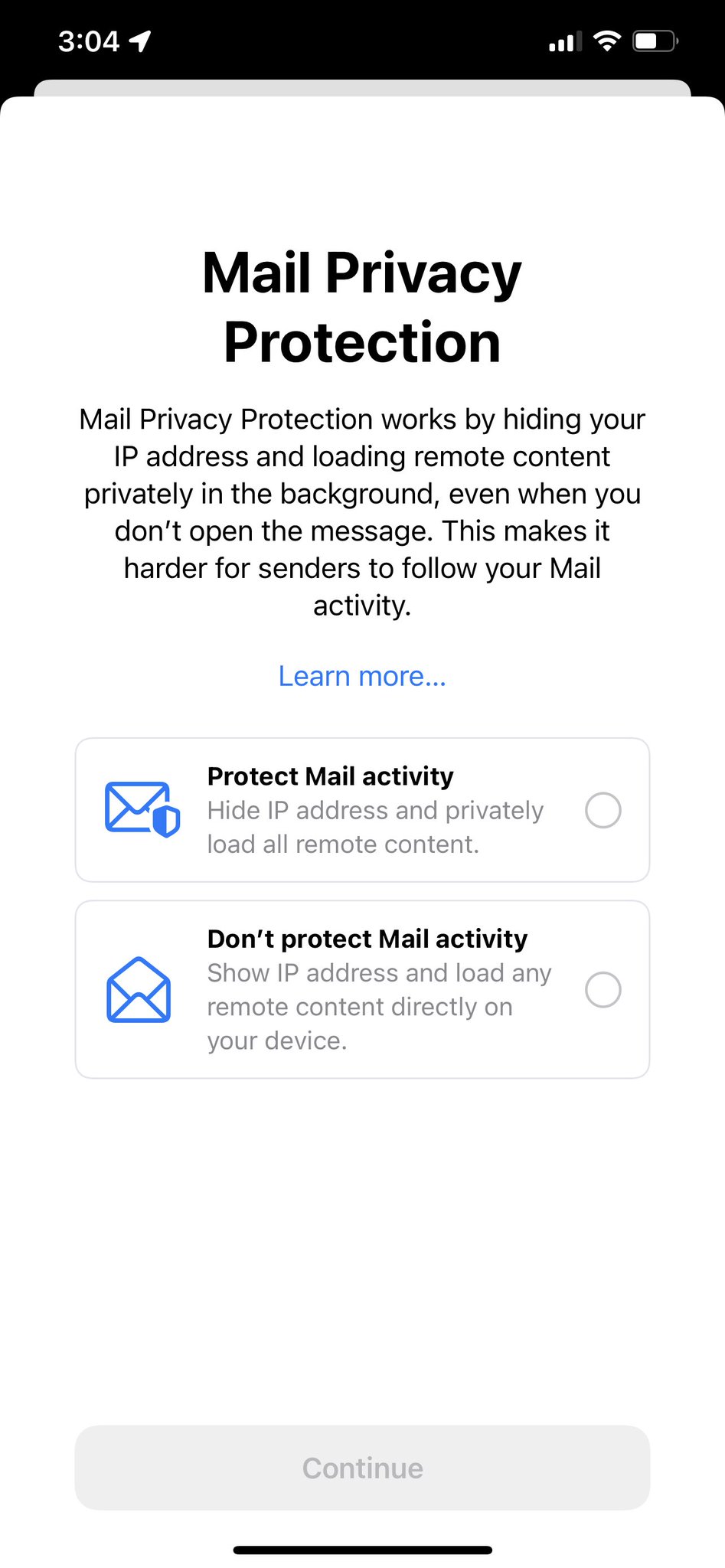Email marketers have been presented with a new reality after the release of Apple’s iOS 15 updates in September 2021. Changes in data privacy, among other things, have created widespread panic among email marketers, with some even speculating that email marketing as we know it may be on its way out. Now that the dust has settled, let’s look at how Apple iOS 15 has impacted email marketing and what you can to do adapt.
New iOS 15 privacy features
Apple announced the rollout of several new iOS 15 privacy features during its Worldwide Developers Conference in June, including:
Mail Privacy Protection (Free): Apple Mail will allow users to opt-in to mail privacy features that mask IP addresses and prevent third parties from tracking email openings or other IP data, according to reports from Litmus, people with early access to iOS 15, and other tech journalists.
iCloud+ (Subscription): An iCloud membership with additional privacy features, such as a VPN-like Private Relay feature that prohibits sites from monitoring Safari users who opt-in and lets users know which websites they’re transferring data to.
Hide My Email (Within iCloud+): An email address cloaking feature that allows users to provide fake email addresses to websites. While promotional emails sent to the fake email will still reach the intended recipient and should have no effect on crucial communications, companies will not be able to see the contact’s genuine email address until the contact shares it.
While the paid features may not have a significant impact on marketers because they need customers to purchase a service, the free Apple Mail privacy feature has already generated a stir among marketers. Although Apple hasn’t stated whether Mail Privacy Protection (MPP) will be an opt-in or automated feature, some iOS testers have published screenshots of the Mail App prompting them to enable it when they open it.
When users choose to protect their email activity, it has an impact on open tracking in emails. It also gives control to email recipients to choose whether or not their email openings are tracked.
What is open tracking and how does it work?
Open tracking is a method used by email service providers (ESPs), to calculate open rates. It works by including a little 1px graphic at the bottom of the email that is unique to the subscriber. The ESP assumes that the email has been opened by the recipient when the unique image loads. This is then reflected as an open-in email campaign report. Open tracking has shown to be beneficial in providing insight into an email’s performance, at least in terms of opens. Apple Mail (on MAC and iOS) will now load the 1px graphics in an email as soon as it is received, thanks to Mail Privacy Protection. Even if the recipient hasn’t physically opened the email.
Remember: Mail Privacy Protection only pre-fetches images when the device is connected to a power source and Wi-Fi.
How has Apple’s Mail Privacy Protection impacted email marketing?
How you use your email marketing tool will determine the impact of Apple’s Mail Privacy Protection on your email marketing campaigns and reports. For instance, how much automation do you utilise in your email sequences and how often do you split test subject lines? However, before we look at what steps you may take, let’s look at the most affected areas:
Open rate and IP data collection
The new feature, understandably, has an immediate impact on the collection of open rate and IP data. Your open rate is one of the most crucial email marketing metrics since it indicates whether or not your recipients are interested in your messages. Analysing this data, in particular, can assist you in improving your subject lines and email copy. Marketers can’t tell if iOS users connect with their campaigns or if their subject lines resonate with them because open rate data isn’t available. Similarly, gathering IP data allows businesses to establish diverse categories to boost engagement and conversion rates. IP-based segmentation becomes ineffective when this is removed.
Automated workflows
Marketing automation was also affected by the recent changes. The reason is straightforward. Specific flows based on subscriber involvement will not work because your automated workflows require data to function. For example, re-engagement workflows based on open no longer work due to the lack of sufficient data. Because marketing automation is such a strong tool for streamlining your business activities, the iOS 15 update was one of the most significant obstacles that email marketers had to overcome.
Optimisation email deliverability
A high-performing and successful email marketing strategy is founded on the foundation of email deliverability. Deliverability tracking was also affected by the removal of a large piece of open data. This measure is the most important indicator that your strategy needs to be improved for your emails to reach the inbox.
Customer behaviour-based segmentation
To send valuable and relevant content, segmenting your list is a good idea. A number of these segments that relied on open and IP data stopped working after the iOS upgrade. Due to data restrictions, a segment formed to target non-openers with tailored content can no longer function.
Live data usage
Another aspect of the new update that has been impacted is the use of live data. Marketers that used countdown timers in their eCommerce email marketing strategy ran into issues because the option was no longer available.
Email list cleaning
Finally, email list cleaning is a procedure that can help you enhance a variety of areas of your email strategy, including deliverability, sender reputation, and conversions. However, to execute effective list cleansing, you must track subscriber activity and delete inactive people. The lack of data made this process more difficult to complete.
How to adapt to the iOS 15 updates
While the changes will affect your open rate data, your click-through, bounce, and unsubscribe data will not be affected. Here’s how to put them all together to adjust to the new circumstances:
Run A/B tests before all users update to iOS 15
Users are still updating to the new iOS 15, according to the latest data, with a current adoption rate of 48%. While this represents nearly half of iPhone users, you may utilise this time to optimise your email strategy before the new function is widely adopted. Start A/B testing your topic lines as one of your options. This method will allow you to discover the variants that your target audience like.
You may then use the information to create headlines that will appeal to them. One of the most powerful email marketing techniques you can utilise to improve your email marketing approach is A/B testing. So, when you’ve fully adopted iOS 15, keep testing your email copy to verify that your recipients are getting the most useful and relevant content.
Continue to follow updates from Apple
Even though Apple’s iOS 15 features have started to roll out, there’s still a lot we are learning about how they’ll affect how we use email. As the feature becomes more widely available, ensure your email product team investigate these changes and considers further solutions, if there will be a major open rate impact.
Invest in email list management tools
To have high engagement and conversions, it’s a no-brainer to manage your lists. Email list management is a method for organising your contacts, understanding their needs, and then delivering the appropriate material to them. While analysing your open rate is the most effective technique to identify inactive subscribers, you can also use other indications like your click-through rate to better manage your iOS contacts. Then, to increase deliverability and avoid being marked as spam, you can start eliminating your disengaged users.
This change will not affect all email readers
Even though Apple Mail and Apple mobile devices account for more than 35% of the global email provider market share, Google, Outlook, and other email providers have yet to make similar privacy announcements, which means that their open and IP data could still provide valuable tracking information for email marketers. While you should be sceptical of other companies, such as Google or Microsoft, following suit on email privacy, keep in mind that you’ll still get open data from them for the time being, and you’ll still be able to make some judgements on the success of opens from these email providers.
You’ll need an email list management tool that gives you the necessary tools for the task if you want to better manage your subscriber list. HubSpot, for example, already has a number of capabilities that can assist you in keeping your contact lists up to date. They also integrate with many email verification providers, allowing you to verify the validity of your subscribers’ email addresses.
Adjust your open-rate goals
Although open rates are unlikely to decline anytime soon, a sizable portion of email readers may become untraceable. As a result, you may need to lower or pivot your open rate goals to determine your new low, average, and high open rates. If your goals are set by a manager above you, it’ll be critical to audit and disclose how many openings you typically get from iOS users so that your manager and the team can forecast how things will change following the release. You might also want to keep track of your email open rates for a month or so following the launch to see if new averages emerge from hard data.
Make use of data from other email marketing data
While open rate is a critical email marketing key performance indicator (KPI) for many businesses, it’s far from the only metric you can use to gauge how effective your email content is. Here are a couple more to consider, even if open rates are affected:
Clicks and click-through rate
When you send emails with links to content like blogs, product sites, and offers, the number of clicks and click-through rates provide information on how many and how often email recipients engaged with and clicked on your content. High clicks or click-throughs indicate that your content was very engaging, whereas low clicks or click-throughs indicate that your readers were only skimming through your email.
Traffic to your site
You can assess how much traffic came to your website from a single email — or which pieces of content sent the most visitors to your site — using software like Google Analytics or tracking URLs. Finally, if you want to grow your audience, encourage people to buy anything, or increase offer downloads, you’ll need to direct visitors to your website. Good email traffic indicates that your content is reaching users to where they need to go.
Click maps
Many email providers, allow you to view which parts of the email received the most or least clicks. This can help you figure out which parts of your email were the most and least clicked.
Unsubscribe rates
A high unsubscribe rate could suggest that a part of your email strategy (such as the content you sent or the frequency with which you send emails) led you to lose more subscribers than usual. In the meantime, a continuously low unsubscribe rate indicates that you’re keeping or even gaining subscribers.
Survey or email persona research
You can use additional tactics, such as surveys or polls, to learn more about your subscribers’ interests, what they’d want to see more of, and where you can enhance your content, in addition to the stats you can get from your email marketing platform.
You can also use email tools or benchmark reports to examine how your email rates compare to those of other brands in your industry, in addition to using KPIs that are less affected by Apple’s shift.
Content evolution
Apple’s declaration isn’t the first time the company has changed its mind about privacy, and it won’t be the last. Even if the world is changing in ways that present issues for digital and email marketers, it doesn’t mean you can’t keep innovating your strategy to meet prospects and audiences where they are. While open rates are crucial, there are many other methods to get to know your email readers, learn from KPIs, and continue to provide them with valuable content.
The truth is that whether or not Mail Privacy Protection influences your email campaign is dependent on several factors. And it’s not something you have much control over. Instead, stick to the basics of email marketing:
- Gather the email addresses of people who want to be contacted by you.
- Deliver engaging content that inspires and educates your audience.
- Use broader engagement metrics to measure success.
- Make it simple for people to opt-out.
If you follow these steps, your email marketing campaigns will remain effective, with Mail Privacy Protection or not.
Related Reading:
The Benefits of Effective Email Marketing (+Tips on How to Grow Your Mailing List)






